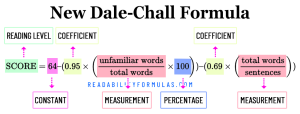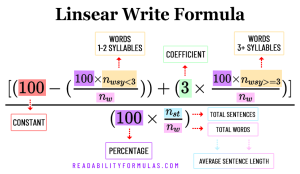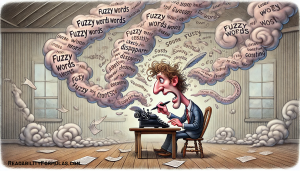 It’s easy to assume from the term “readability formulas” that such formulas measure reading ease or comprehension–which, they do not. Nonetheless, writers use these tools to meet a target reading level, such as “write it at the sixth grade level.”
It’s easy to assume from the term “readability formulas” that such formulas measure reading ease or comprehension–which, they do not. Nonetheless, writers use these tools to meet a target reading level, such as “write it at the sixth grade level.”
When writers use readability scores as a criterion, they do so with good intentions: they want to know their material is not too difficult for their readers. While it’s important to match reading skills with content, a grade level does not—by itself—ensure the match is perfect. Using grade level standards can lead writers to produce text that is less readable, even though it scores at a lower grade level.
Readability formulas that lean more on sentence length can produce lower grade levels for texts by simplifying sentence structure, according to research by the journal Educational Psychology . However, this did not always result in better comprehension for readers.
If you must meet a standard of a “sixth grade level,” and your material scores at an 8th grade level, what can you do? It’s tempting to skew the text by dividing sentences and substituting shorter words. Although this type of editing will improve the grade level score, it may make your text choppy and harder to read. And your readers may still not benefit.
Here’s why:
1. WORD MEANING: Simplifying vocabulary can reduce the meaning and effectiveness of words. Sometimes longer words are more specific and accurate in conveying meaning. For example: in user manuals for complex machinery, technical jargon is often used for clarity. Replacing “integrated circuit” with “tiny electronic component” may be more accessible, but might not provide users with enough information to troubleshoot effectively. Swapping jargon out with simpler synonyms may cause you to dilute the intended message and potentially confuse your readers. Sometimes a longer word is a familiar word, so why change it?
2. CONTEXTUAL MEANING: Sometimes readers need to know the longer word. Teaching its meaning may require you to repeat the longer word several times. Example: when translating historical texts, altering complex historical terms can distort the understanding of events and concepts. Replacing “Renaissance” with “Rebirth” simplifies the term but doesn’t capture the full historical and cultural context. Repeatedly using shorter, simpler words to replace long words can make the text less concise and more cumbersome—simply because you need more sentences or explanations to capture the meaning.
3. EDUCATIONAL VALUE: Longer words can serve an educational goal because you introduce readers to new vocabulary. If you consistently substitute complex words with simpler alternatives, you miss an opportunity to expand your readers’ vocabulary and help them grow as readers.
4. SENTENCE FLOW: Shortening too many sentences can disrupt the flow of your writing. Sentences should vary in length to maintain a rhythm and prevent monotony. Constantly breaking down sentences can result in a choppy and less engaging reading experience—you inflict a new burden on your readers to supply the connections you just removed.
5. READER ENGAGEMENT: Engaging your readers involves a mix of sentence lengths and vocabulary levels. Readers appreciate a certain nuance of complexity and word variety. Overly simplifying makes your writing style stale and boring.
6. ACCESSIBILITY vs. READABILITY: Readability is essential, but so too is accessibility. Balance the two. Readers may prefer a higher reading level if they can gain valuable insights and information.
A survey of 500 teachers conducted by the National Council of Teachers of English found that 76% of educators believe that focusing on grade-level readability can lead to uninspiring and overly simplified texts, ultimately failing to challenge and engage students effectively.

Matching grade levels to text can cause other problems, such as:
1. FALSE ASSUMPTIONS: Using a grade level score may provide a false sense of confidence and cause you to miss problems with your text.
2. ROUGH ESTIMATES: Using grade level scores may encourage you to treat such scores at face value, rather than as rough estimates. Because scores can vary and be unreliable, it makes sense to interpret these scores with caution.
3. UNIQUE READERS: Your readers come from various backgrounds, age groups, and expertise. Ignoring these traits can lead to excluding a large percentage of your audience.
A survey conducted by the Pew Research Center shows that reading preferences differ significantly among adults. While 40% prefer content written at or below an eighth-grade level, a substantial 57% prefer content that is more advanced, reflecting the need for diverse reading materials.
Grade Level Accuracy
The accuracy of grade levels or reading scales can vary. Scores for the same text can differ by two, three, or more grade levels. Some formulas add a decimal, such as “5.3 grade.” Scores with a decimal point are not as precise as they sound. Additionally, if you use a computerized formula, you need to prepare your text first to avoid misleading results.
FYI: The Flesch-Kincaid produces a grade level score. Be careful not to confuse the Flesch-Kincaid with the other Flesch test, which is called the Flesch Reading Ease. The Flesch Reading Ease Scale (also known as the Flesch Index) is a score from 0 to 100 that you interpret with a chart. For this formula, higher scores mean easier to read. For example, a score of 70 to 80 means “fairly easy” and a seventh grade reading level.
Several factors affect grade level accuracy:
1. Formula Variation: Different readability formulas may yield different grade levels for the same text. Each formula has its own algorithms and they may score factors differently like sentence length, word complexity, and syllable count. This can result in discrepancies in the output.
A study conducted by researchers at the University of California, Berkeley found that using multiple readability formulas (e.g., Flesch-Kincaid, Gunning Fog, Coleman-Liau) to score text, the assigned grade levels often varied by one or more grade levels.
Sometimes readability scores are based on scoring the entire document. Other times, especially for long documents, formulas base their scores on samples. Usually, the formulas base the average score across three, 300-word samples. The grade-level result may differ if you select different size samples throughout the document.
2. Context and Content: The complexity of subject matter and how well it aligns with the readers’ prior knowledge and interests can influence the grade level.
In a study published in the Journal of Literacy Research , researchers analyzed the grade-level assignments of science textbooks using readability formulas. Grade levels often misaligned with the cognitive development of readers due to the complexity of the subject matter.
3. Reader Background: Readability formulas assume a general reader—typically an 8th grade reader—but real readers have diverse backgrounds, experiences, and literacy skills. What one reader considers readable, a different reader may find challenging.
A survey conducted by the National Assessment of Adult Literacy found that readers’ backgrounds influenced their comprehension of texts assigned the same grade level by readability formulas. Readers with more education and higher literacy skills often found texts assigned lower grade levels to be too easy.
4. Language Diversity: Readability formulas may not account for language variability, idiomatic expressions, or cultural nuances that can affect comprehension. This can lead to grade levels that incorrectly reflect the text’s ease of understanding.
In a study analyzing the readability of texts for English language learners, researchers found that readability formulas did not always accurately reflect the linguistic and cultural background of the readers—this led to inaccuracies in grade level assignments.
5. Sentence Structure: Some formulas weigh more heavily on sentence length. While shorter sentences are generally easier to read, removing long sentences can lead to oversimplify the text. The result may falsely reflect the readability of content-rich or technical material.
6. Algorithm Limits: Readability formulas cannot assess a text’s clarity, coherence, organization, or visual aids (e.g., illustrations or charts). These elements can significantly impact readability.
7. Subjectivity: Comprehension is a subjective process influenced by reader engagement, motivation, and background knowledge. These formulas cannot measure how well readers comprehend or engage with a text.
8. Evolving Language: Language evolves over time. Readability formulas may not adapt quickly to reflect changes in language usage and vocabulary.
9. Specialized Texts: For specialized or technical texts, readability formulas may incorrectly assess readability because they are designed for general reading materials.
In the context of medical information, a study published in the Journal of Health Communication found that readability formulas often underestimated the complexity of medical texts, which required a higher level of health literacy than indicated by the formulas.
 If you need to meet a lower grade-level for your text, you can following these tips:
If you need to meet a lower grade-level for your text, you can following these tips:
- Simplify: Use simpler vocabulary and sentence structures. Replace complex words with simpler synonyms and break down long sentences into shorter ones.
- Use Plain Language: Plain language is a writing style that conveys information clearly and concisely. It avoids jargon, technical terms, and convoluted expressions.
- Shorten Paragraphs: Keep your sentences and paragraphs short and to the point. Long and complex sentences can challenge less experienced readers. Use bullet points or lists to break down information when appropriate.
- Organize Content Logically: Ensure your content is well-organized. Use headings, subheadings, and a clear structure. Guide the reader through the text. Information should flow logically from one point to the next.
- Definitions: If you must use unfamiliar technical terms or terminology, provide clear definitions and context. Define terms the first time, and consider including a glossary.
- Use Visuals: Use visuals like images, diagrams, and charts to help illustrate key points and concepts. Visuals can convey information more effectively than text alone.
- Feedback: Have people from your target audience review your text and provide feedback.
- Use Readability Tools: Use the online Robert Gunning Editor to help identify wordiness and complexity in your writing.
- Edit and Revise: Edit and revise to simplify your text. The goal is to make the content as clear and accessible as possible.
- Audience: If possible, conduct user testing with your target audience. Find out if your revised content meets their reading skills.
Bottom Line: Readability scores encompass only a few factors that affect the ease or difficulty of text. Counts of syllables and sentences cannot tell you if the layout is effective, or if your writing is clear, cohesive, and well-organized. These counts cannot tell you if readers find the information appealing, easy to understand, and easy to use. It screens for difficulty of words and sentences, but it does not consider the life experience, literacy skills, and educational backgrounds of readers.
Scott, Brian. “Understanding Grade Levels and Readability Scores.” ReadabilityFormulas.com, 24 Nov. 2024, https://readabilityformulas.com/understanding-grade-levels-and-readability-scores/.





